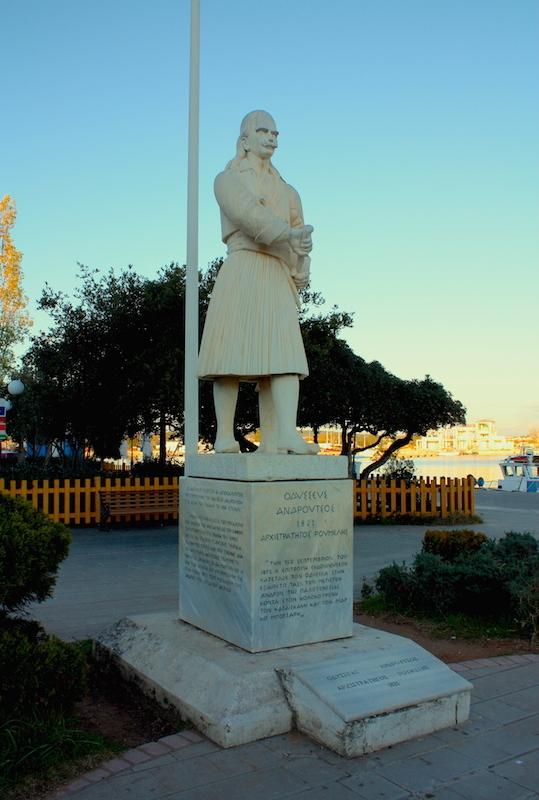In the late 1700s Preveza was a safe haven for klepths and armatoloi who sought protection under Venetian rule. Some repaid their hosts by stealing flocks or fish stocks and abducting Ottoman and Venetian subjects. Others developed local economic and familial ties. Odysseas Androutsos (1790-1825) was the son of Andreas Verousis and Akrivi Tsarlamba. His mother was born in Preveza and their house was on 29 Xristos Kontos street. His father assisted Lambros Katsonis during the Russo–Turkish War (1787–1792) and was executed by the Turks when Odysseas was 7 years old. The family escaped to the island of Lefkada but returned to Preveza shortly thereafter. Odysseas stayed in Preveza until 1806.
1. Odysseas Androutsos square
Odysseas Androutsos' marble statue honours a leading figure of Greece’s independence struggle. It was erected close to the fortress of St. Andreas, former seat of the town’s Ottoman rulers.
Stories
Safe haven
In the mountains of central Greece
Androutsos joined the service of Ali Pasha of Ioannina at a young age. He made a career for himself in various posts but made sure to develop secret ties to various revolutionary groups. In 1818 he joined the Filiki Eteria (or Society of Friends) and attempted to organize a Greek-Albanian alliance of military leaders who were in the service of Ali Pasha. In January 1821 Androutsos was selected as leader of the upcoming revolutionary fight in eastern Central Greece. In March he attacked an Ottoman money train but left the money behind to prove his pure revolutionary intentions.
The glorious inn
In late spring 1821 the Greek War of Independence was raging. The Ottomans gathered forces in the north, under the leadership of Omer Vrioni, to crash the revolution. His plan was to secure the renewed obedience of select Greek revolutionary leaders. His overtures to Androutsos resulted in the latter taking up a defensive position at an inn near Gravia in Phokis with 117 men. He fought for a whole day to prevent the Turks from moving further south. The enemy lost 300 men while the Greeks only lost two men. When the fighting stop while the Turks waited for the arrival of canons, the Greeks managed to escape undetected through the Ottoman lines. Vrioni abandoned his campaign.
Preveza in 1821
Preveza was protected by numerous forts, geography, and the Ottoman fleet stationed in the Ambracian Gulf. In 1820 the local garrison was reinforced by thousands of soldiers who participated in the campaign against Ali Pasha. Hursid Pasha, who was in charge of the fight against the rebellious Ottoman ruler, felt that Preveza was secure enough to bring here the members of his harem he ransomed after the fall of Tripolitsa. The presence of a strong Ottoman army impeded the Greek revolutionary efforts. The residents of Preveza distinguished themselves through the raising of funds to ransom Greeks captured in the fighting further south, especially following the fall of Missolonghi in 1826.
Revolutionary compensation
The question of moral and material rewards for the participants in the Greek War of Independence was a thorny one. The jealousies and clashes between military and political leaders, as well as the near impossible task of establishing each person’s level of contribution, wreaked havoc with the process. The initial plan of remunerating them with land abandoned by the retreating Turks failed. A committee was established after the arrival of King Otto in 1833. It was tasked with identifying those worthy of recognition and awarding them medals according to their contribution. The applicants submitted a certificate signed by local revolutionary leaders and the mayor of their place of residence.
The bones
In 1825 Androutsos was placed under arrest in the Frankish Tower on the Acropolis of Athens. In June he was assassinated after being thrown from the tower’s top by former comrades. He was buried on the Acropolis. In 1865 the Greek government recognized Androutsos contributions and transferred his remains to the First Cemetery of Athens. In 1967 his remains were returned to Preveza and placed beneath his memorial in Androutsos Square. The statue is a work by Nikolas and depicts Androutsos according to the engraving by the Bavarian painter Karl Krazeisen.
Powered by Clio Muse Tours
